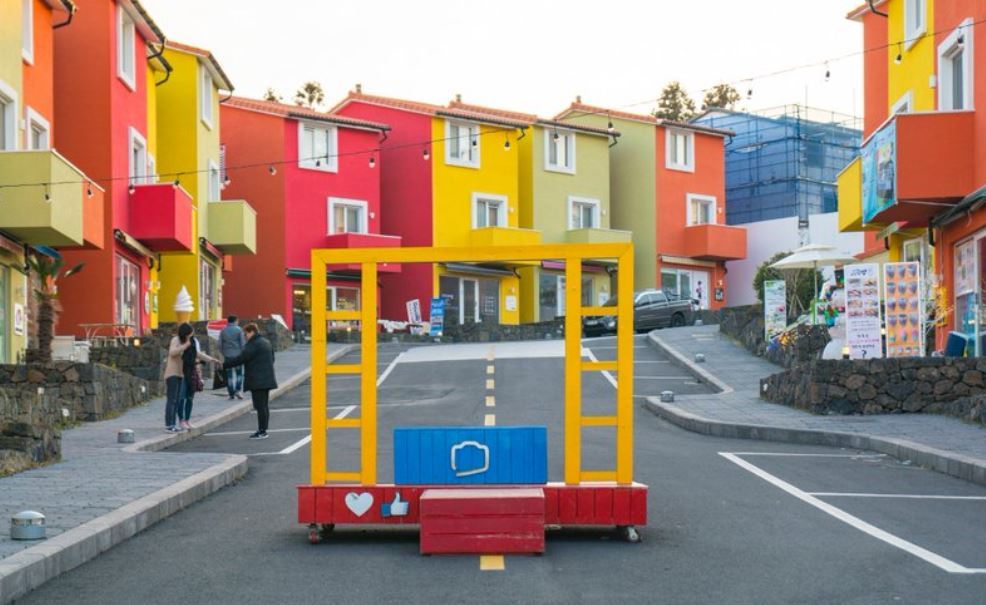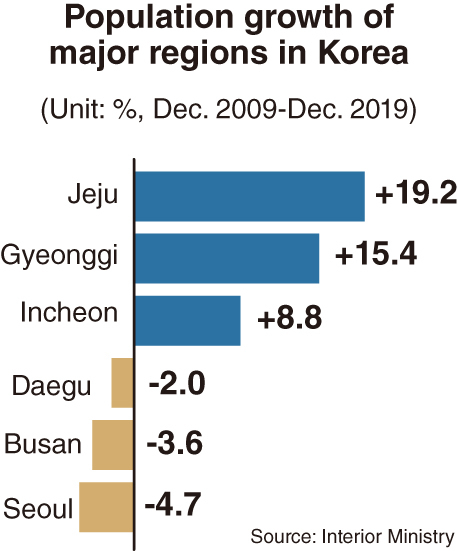[News Focus] Regional population disparity continues to widen in S. Korea
By Kim Yon-sePublished : Jan. 28, 2020 - 16:33

SEJONG -- South Korea’s population has increased by about 2 million, or 4.1 percent, over the past decade from 49.77 million.
Though the nation’s population -- 51.84 million as of December -- has continued to grow, except for only three months in the 2010s, the disparity in terms of variation among 17 major areas (eight cities and nine provinces) has widened, government data showed.
According to the Ministry of Interior and Safety, Jeju Province topped the list in population growth at 19.2 percent from 562,000 to 670,000 over the decade.
This was attributed to land development boom, operation of international schools and urbanites’ rush to the island for purpose of rural life or small businesses.
Gyeonggi Province ranked second with a population growth of 15.4 percent. The region surrounding Seoul marked a noteworthy increase of 1.77 million from 11.46 million to 13.23 million.
More households in Seoul and other regions across the country have moved to new residential towns, built in Gyeonggi’s cities such as Goyang, Gimpo, Bucheon, Hwaseong, Suwon, Yongin, Seongnam and Hanam.

Suwon had the largest population as of December with 1.19 million, followed by Goyang (1.06 million), Yongin (1.05 million), Seongnam (940,000), Bucheon (820,000), Hwaseong (810,000) and Namyangju (700,000).
Incheon (the nation’s third-largest city) ranked third with its population growth reaching 8.8 percent. On the back of its new residential towns like Songdo, Samsan, Geondam and Cheongna, the city saw the number of residents climb from 2.71 million to 2.95 million.
North Chungcheong Province ranked fourth with 5.2 percent at 1.6 million, trailed by South Chungcheong Province (4.4 percent, 2.12 million), South Gyeongsang Province (3.3 percent, 3.36 million) and Ulsan (2.7 percent, 1.14 million).
As an extraordinary case, Sejong recorded 230 percent in growth as it saw the number of residents surge from 103,000 in July 2012 (when the administrative-oriented city was launched) to 340,000 in December.
In contrast, Seoul posted minus 4.7 percent in population growth, which was the biggest fall among the 17 major areas. The number of residents in the capital decreased nearly 500,000 in the 2010s from 10.2 million to 9.72 million.
After peaking at 10.328 million in October 2010, the so-called exodus of Seoul citizens started in early 2010s, though many of them still commute to the capital from Gyeonggi Province or Incheon.
“The population in Seoul has fallen to the level of the 1980s. Apart from high apartment prices, relocation of government offices or agencies and core businesses of conglomerates have affected the sharp drop in the capital,” said a demographic analyst.
Among the 25 wards in Seoul, Songpa topped the list with 670,000 as of last month. Gangseo ranked second at 590,000, followed by Gangnam (540,000), Nowon (530,000), Gwanak (500,000), Eunpyeong (480,000), Yangcheon (450,000), Seongbuk (440,000) and Gangdong (430,000).
Busan ranked second with minus 3.6 percent growth from 3.54 million to 3.41 million. Some predict that the city may cease to be yield its status as the nation’s second-largest city to Incheon in the coming decades, saying that the working-age population is Busan is fast falling.
Other regions which posted a decline in population, were South Jeolla Province (minus 2.6 percent), North Jeolla Province (minus 2.1 percent), Daegu (minus 2 percent), Daejeon (minus 0.6 percent) and North Gyeongsang Province (minus 0.1 percent).
Meanwhile, South Korea’s population, which topped 50 million in September 2010 for the first time in history, is estimated to have stopped its positive growth as of December, with 51.84 million in December from 51.85 million a month earlier.
The January data is drawing wide attention from demographic experts.
By Kim Yon-se (kys@heraldcorp.com)
















![[KH Explains] Hyundai's full hybrid edge to pay off amid slow transition to pure EVs](http://res.heraldm.com/phpwas/restmb_idxmake.php?idx=652&simg=/content/image/2024/04/18/20240418050645_0.jpg&u=20240419100350)

![[Today’s K-pop] Zico drops snippet of collaboration with Jennie](http://res.heraldm.com/phpwas/restmb_idxmake.php?idx=642&simg=/content/image/2024/04/18/20240418050702_0.jpg&u=)